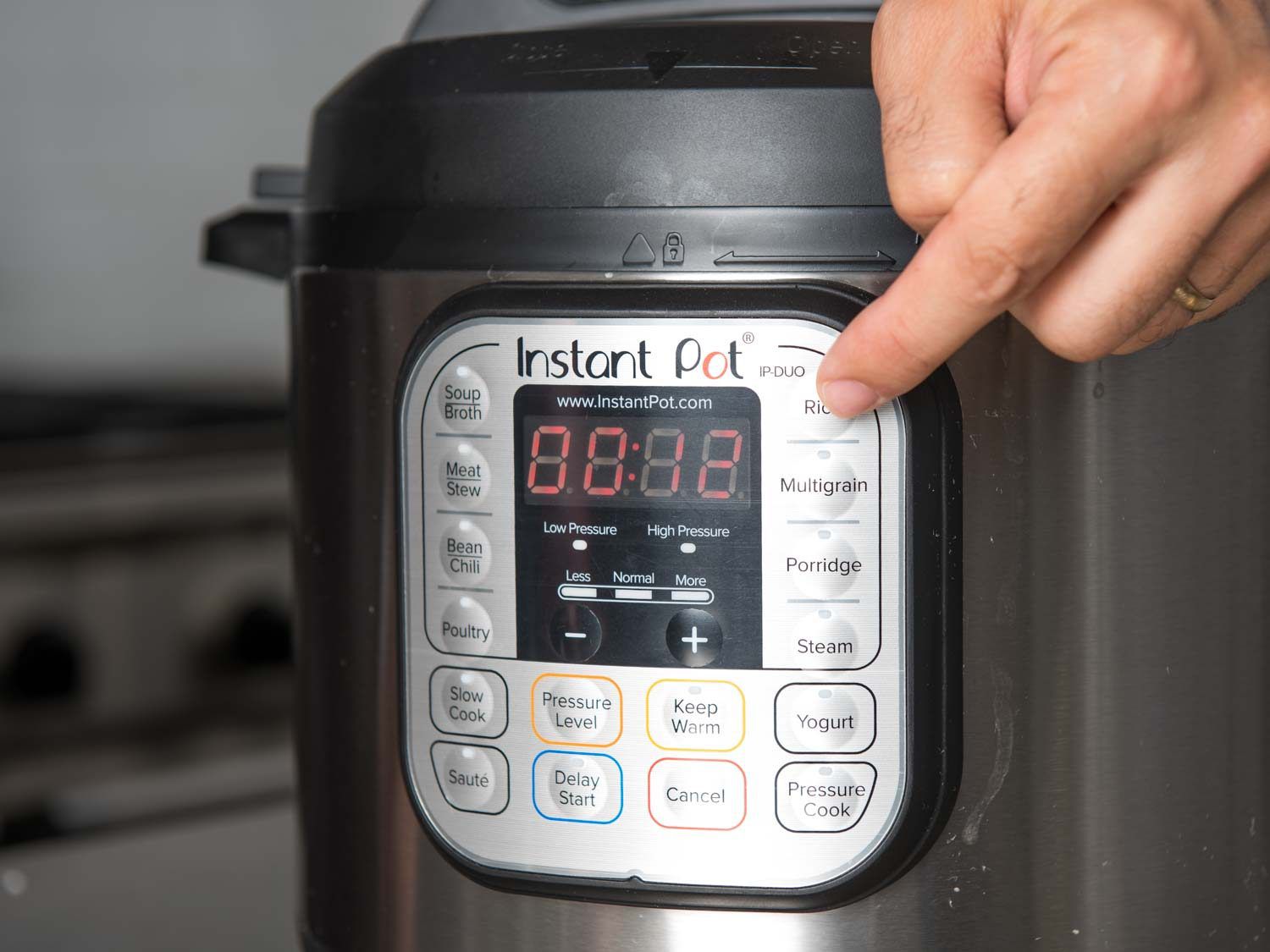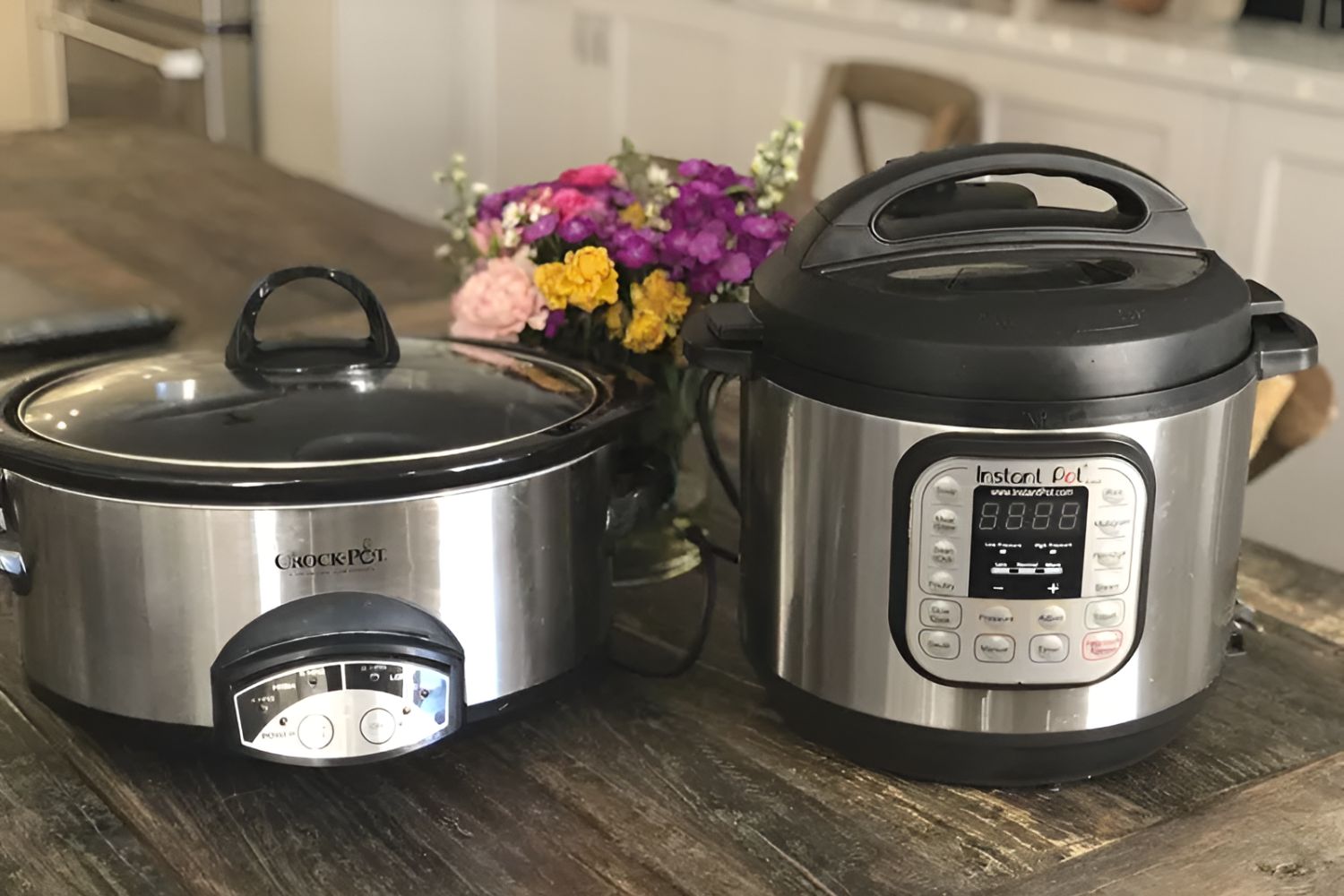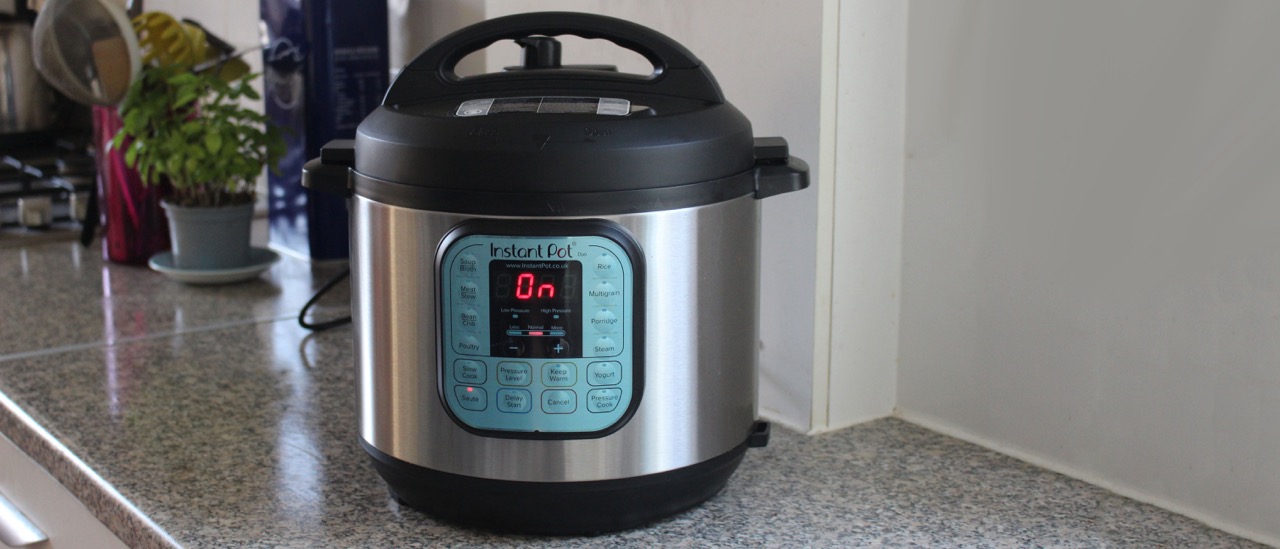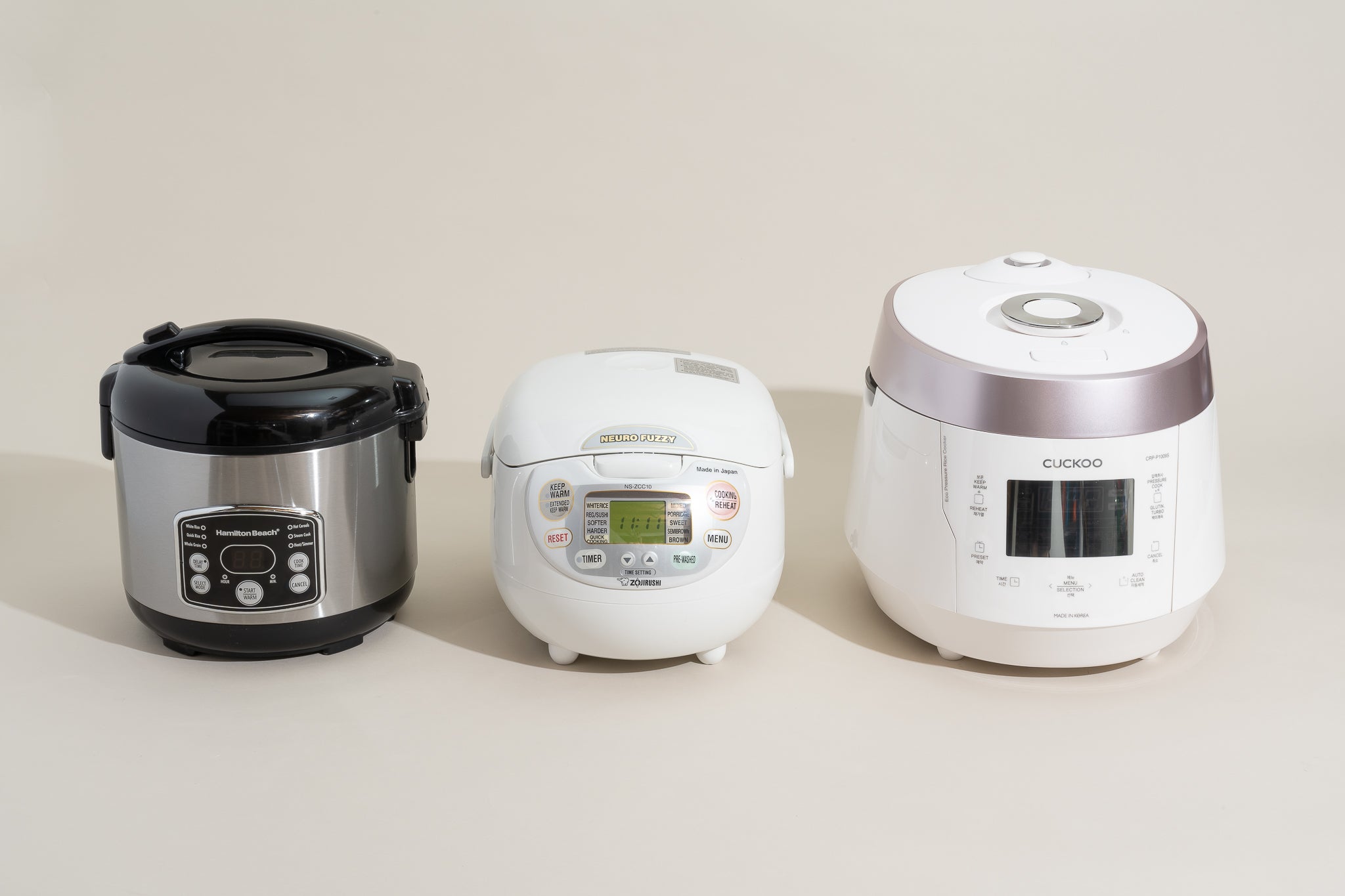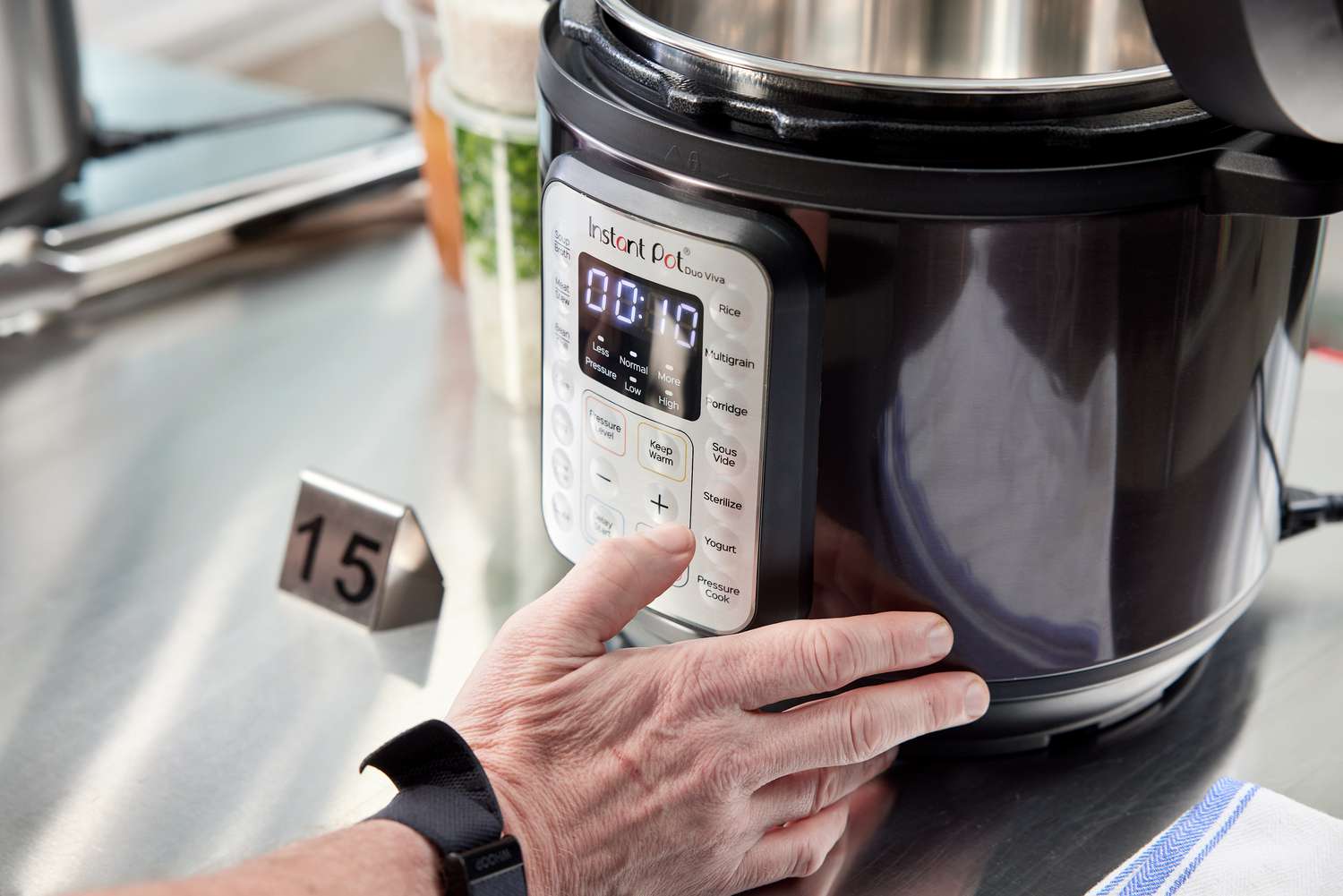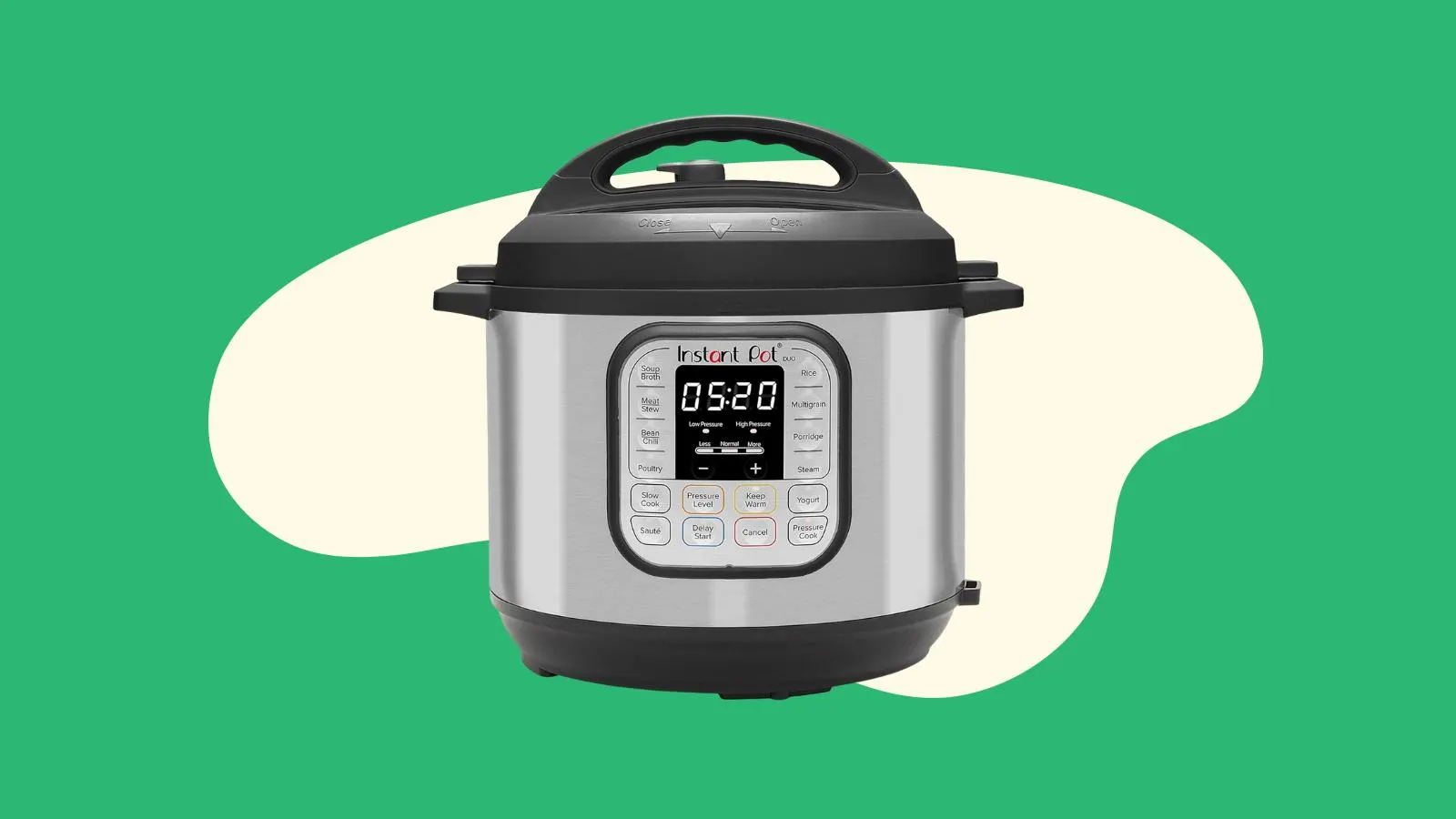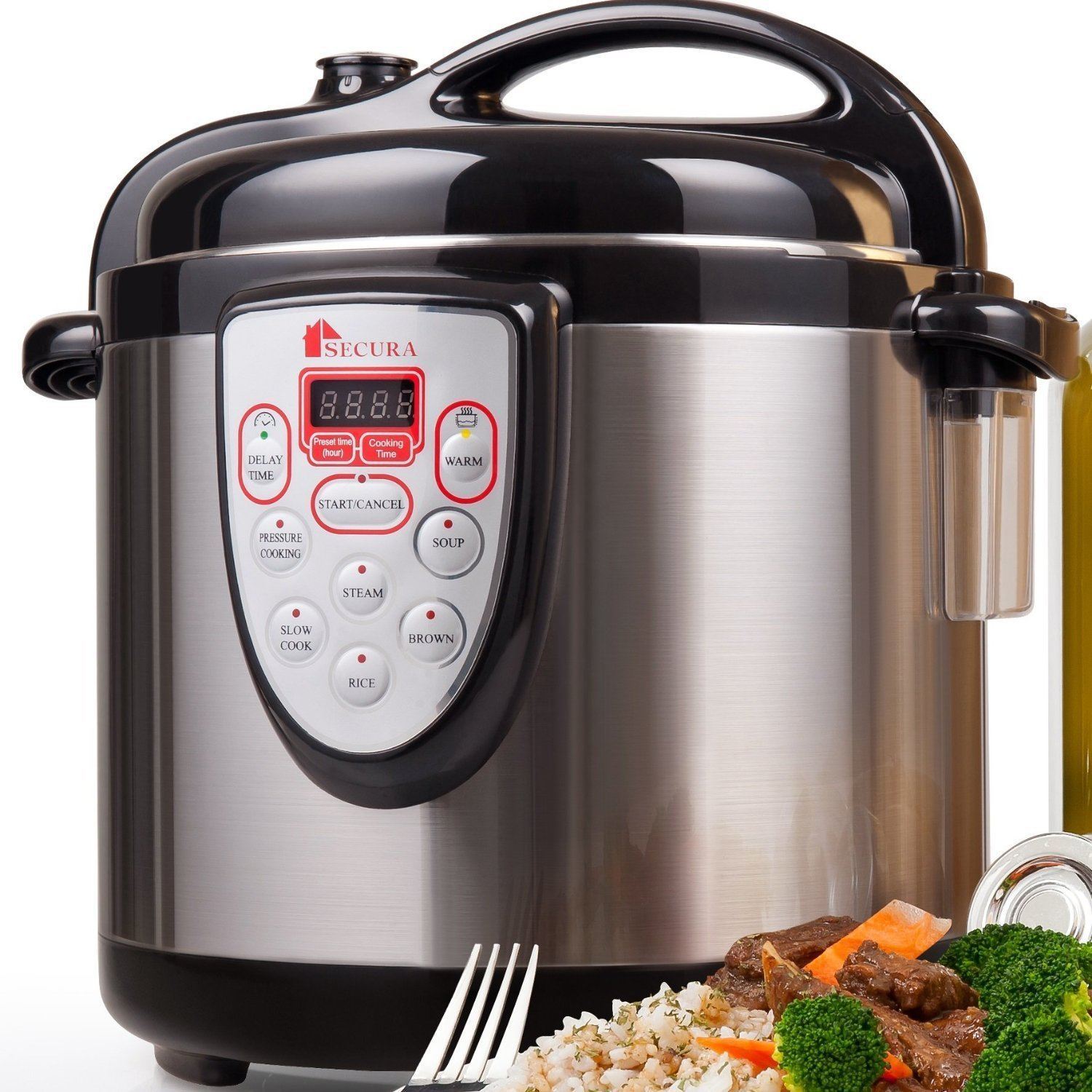Introduction
Welcome to the world of the Instant Pot Electric Pressure Cooker! Whether you’re a seasoned home cook or a culinary novice, this versatile kitchen appliance is sure to revolutionize the way you prepare meals. The Instant Pot Electric Pressure Cooker combines the benefits of a pressure cooker, slow cooker, rice cooker, steamer, and more, all in one convenient device.
Gone are the days of spending hours in the kitchen, slaving over a hot stove. With the Instant Pot Electric Pressure Cooker, you can whip up delicious, homemade meals in a fraction of the time. It’s the perfect tool for busy individuals and families on the go.
Not only does the Instant Pot Electric Pressure Cooker save you time, but it also helps you save energy. Its efficient design and fast cooking process mean less time spent using your stove or oven, reducing your overall energy consumption. Plus, the sealed cooking environment retains heat and moisture, resulting in tender and flavorful dishes.
Another advantage of the Instant Pot Electric Pressure Cooker is its versatility. With a wide array of settings and cooking functions, you can easily prepare a variety of dishes, from soups and stews to rice, beans, and even yogurt. Its intuitive controls and pre-programmed settings take the guesswork out of cooking, making it suitable for cooks of all skill levels.
Furthermore, the Instant Pot Electric Pressure Cooker is designed with safety in mind. It features multiple safety mechanisms, such as a lid-locking system, pressure control, and temperature monitoring, to ensure your cooking experience is worry-free. You can confidently cook meals for your loved ones knowing that the Instant Pot Electric Pressure Cooker prioritizes your safety.
In this guide, we will take you through everything you need to know to make the most of your Instant Pot Electric Pressure Cooker. From setting up and operating the appliance to safety precautions, cooking basics, tips, and tricks, as well as delicious recipes to try, we’ve got you covered. So, let’s dive in and discover the amazing world of the Instant Pot Electric Pressure Cooker!
Benefits of Using the Instant Pot Electric Pressure Cooker
The Instant Pot Electric Pressure Cooker offers a host of benefits that make it a must-have kitchen appliance. Here are some of the key advantages:
1. Time Efficiency:
One of the biggest benefits of the Instant Pot Electric Pressure Cooker is its ability to significantly reduce cooking time. By utilizing high-pressure steam, it can cook food up to 70% faster than traditional cooking methods. This means you can enjoy your favorite meals in a fraction of the time, making it perfect for busy individuals and families.
2. Versatility:
The Instant Pot Electric Pressure Cooker is not limited to just one cooking function. It comes with a range of preset programs and customizable settings that allow you to pressure cook, sauté, steam, slow cook, make yogurt, and much more. This versatility makes it a versatile tool that can replace multiple kitchen appliances, saving you valuable counter space.
3. Energy Efficiency:
Thanks to its innovative design, the Instant Pot Electric Pressure Cooker uses less energy compared to conventional cooking methods. The sealed cooking environment traps heat and moisture, reducing cooking times and minimizing heat loss. This not only saves you money on your energy bill but also helps to reduce your carbon footprint.
4. Nutritional Benefits:
The high-pressure cooking process of the Instant Pot Electric Pressure Cooker helps to retain more vitamins and nutrients in your food compared to traditional cooking methods. It preserves the natural flavors and textures of ingredients while ensuring that essential nutrients are not lost during the cooking process.
5. Consistency in Results:
The Instant Pot Electric Pressure Cooker takes the guesswork out of cooking. It provides precise temperature and pressure control, ensuring consistent results every time. Whether you’re cooking tender meats, perfectly cooked grains, or flavorful soups, you can trust the Instant Pot Electric Pressure Cooker to deliver consistent and delicious meals.
6. Safety Features:
The Instant Pot Electric Pressure Cooker is designed with your safety in mind. It comes equipped with safety features such as lid-locking systems, pressure control, and automatic temperature monitoring. These features help prevent accidents and ensure that you can cook with confidence.
With its time-saving capabilities, versatility, energy efficiency, nutritional benefits, consistent results, and built-in safety features, it’s easy to see why the Instant Pot Electric Pressure Cooker has become a kitchen essential for many households. Now that you know the benefits, let’s explore how to set up and operate your Instant Pot Electric Pressure Cooker.
Getting to Know Your Instant Pot Electric Pressure Cooker
Before you dive into cooking with your Instant Pot Electric Pressure Cooker, it’s important to familiarize yourself with its features and functions. Let’s take a closer look at the various components and settings of your Instant Pot Electric Pressure Cooker:
1. Control Panel:
The control panel is where you’ll find the buttons and settings to operate your Instant Pot Electric Pressure Cooker. It typically includes buttons for different cooking functions, pressure level selection, timer settings, and a display screen to show the cooking progress and settings.
2. Lid and Sealing Ring:
The lid is an important component of the Instant Pot Electric Pressure Cooker. It is designed to seal tightly and lock in the pressure while cooking. The sealing ring, located inside the lid, ensures a secure and airtight seal during cooking. It’s essential to regularly inspect and clean the sealing ring to maintain its integrity and efficiency.
3. Pressure Release Valve:
The pressure release valve is a crucial safety feature of the Instant Pot Electric Pressure Cooker. It allows you to manually release the pressure after cooking or choose between quick release and natural release methods. Understanding how and when to use the pressure release valve is vital to ensure safe operation of your Instant Pot Electric Pressure Cooker.
4. Inner Pot:
The inner pot, also known as the cooking pot, is where you place your ingredients for cooking. It is usually made of stainless steel and is removable for easy cleaning. The inner pot is marked with measurements to help you accurately portion out your ingredients.
5. Accessories:
Many Instant Pot Electric Pressure Cooker models come with accessories that enhance its functionality. These can include a steam rack, trivet, additional sealing rings, and a measuring cup. Each accessory has its own purpose and can be used for various cooking techniques.
6. Cooking Functions:
Your Instant Pot Electric Pressure Cooker offers various cooking functions, such as pressure cooking, sautéing, steaming, slow cooking, rice cooking, and yogurt making. Each function is designed to optimize the cooking process for specific types of dishes, giving you versatility in your culinary endeavors.
By familiarizing yourself with these components and functions, you’ll be well-equipped to make the most of your Instant Pot Electric Pressure Cooker. In the next section, we’ll explore how to set up and operate your appliance, so you can start creating delicious meals in no time!
How to Set Up and Operate the Instant Pot Electric Pressure Cooker
Setting up and operating your Instant Pot Electric Pressure Cooker is a straightforward process. Here’s a step-by-step guide to help you get started:
1. Read the Manual:
Before you begin, it’s crucial to familiarize yourself with the user manual that comes with your Instant Pot Electric Pressure Cooker. The manual provides essential information about the appliance’s features, functions, and safety precautions. Take the time to read and understand it thoroughly.
2. Assemble the Instant Pot:
Start by assembling your Instant Pot Electric Pressure Cooker. Place the inner pot into the base unit and ensure it is securely in place. Attach the lid, making sure it locks into position. Check that the sealing ring is properly positioned inside the lid.
3. Add Ingredients:
Add the desired ingredients to the inner pot according to your recipe. Be mindful not to overfill the pot, as ingredients will expand during cooking. If using the sauté function, preheat the pot and add oil, onions, or other ingredients as required.
4. Select Cooking Function:
Use the control panel to select the appropriate cooking function for your recipe. The buttons on the control panel vary depending on the Instant Pot model, but they typically include options for pressure cooking, sautéing, steaming, slow cooking, and more. Choose the function specified in your recipe or manually adjust the time and temperature settings.
5. Set Cooking Time and Pressure Level:
Once you’ve selected the cooking function, set the cooking time and pressure level if necessary. Some recipes may require a specific cooking time and pressure, while others will automatically select the optimal settings based on the chosen function. Refer to your recipe or consult the user manual for guidance on time and pressure settings.
6. Start Cooking:
After setting the cooking parameters, close the Instant Pot Electric Pressure Cooker by placing and sealing the lid. Make sure the pressure release valve is in the correct position (either sealed or venting, depending on the recipe). Press the start button or the corresponding button for your chosen function to initiate the cooking process.
7. Natural or Quick Release:
Once the cooking time is complete, you have two options for releasing the pressure: natural release or quick release. Natural release involves allowing the pressure to subside naturally, which can take some time. Quick release, on the other hand, involves manually releasing the pressure using the pressure release valve. Consult your recipe or the user manual to determine the appropriate release method.
That’s it! You have successfully set up and operated your Instant Pot Electric Pressure Cooker. In the next section, we’ll cover some important safety precautions to keep in mind while using your appliance.+
Safety Precautions to Follow While Using the Instant Pot Electric Pressure Cooker
When using the Instant Pot Electric Pressure Cooker, it’s important to prioritize safety to ensure a worry-free cooking experience. Here are some key safety precautions to keep in mind:
1. Read the Manual:
Before using the Instant Pot Electric Pressure Cooker, carefully read and understand the user manual. It contains vital information about the appliance’s safety features, operating instructions, and maintenance guidelines. Familiarize yourself with the manual to ensure proper and safe usage.
2. Proper Venting and Sealing:
Ensure that the pressure release valve is in the correct position before starting the cooking process. For recipes requiring pressure cooking, set the valve to the “sealing” position to allow pressure buildup. On the other hand, for recipes requiring manual pressure release, position the valve to “venting” to release the pressure safely.
3. Avoid Overfilling:
Do not overfill the Instant Pot Electric Pressure Cooker beyond the maximum fill line indicated on the inner pot. Overfilling can lead to clogging of the pressure release valve and increase the risk of accidents. Leave enough space for ingredients to expand during cooking to prevent any potential hazards.
4. Use Appropriate Cooking Liquid:
When pressure cooking, it’s essential to add sufficient liquid to the Instant Pot. Follow the recommended guidelines in your recipe or consult the user manual for minimum liquid requirements. Insufficient liquid can result in burned food or inadequate pressure buildup, impacting both the cooking process and safety.
5. Do Not Force Open the Lid:
Never force open the Instant Pot Electric Pressure Cooker’s lid while it is still under pressure. The lid is designed to remain locked until the internal pressure has been released. Forcing the lid open can lead to steam burns or other accidents. Always wait for the pressure to fully release naturally or use the quick release method.
6. Keep Hands and Face Away from Steam:
When releasing pressure from the Instant Pot, keep your hands and face clear of the steam. The steam released during pressure release is extremely hot and can cause burns. Make sure to stand at a safe distance and use utensils or oven mitts to manipulate the pressure release valve.
7. Use Utensils Suitable for the Instant Pot:
When cooking with the Instant Pot Electric Pressure Cooker, use utensils specifically designed for use with the appliance. Avoid using metal utensils that can scratch the non-stick coating of the inner pot or cause damage to the sealing ring. Opt for silicone, wooden, or nylon utensils to prevent any potential harm.
By following these safety precautions, you can safely and confidently operate your Instant Pot Electric Pressure Cooker. Next, let’s explore the cooking basics and tips to help you make the most out of your appliance.
Cooking Basics with the Instant Pot Electric Pressure Cooker
The Instant Pot Electric Pressure Cooker may seem intimidating at first, but once you learn the cooking basics, you’ll be amazed at the ease and speed with which you can create delicious meals. Here are some essential cooking basics to get you started:
1. Be Mindful of Liquid:
Ensuring you have enough liquid in the Instant Pot is crucial for successful cooking. Most recipes require at least 1 cup of liquid to create the necessary steam for pressure cooking. However, recipes with denser ingredients like rice or beans may require additional liquid. Always refer to your recipe or the Instant Pot’s user manual for specific guidelines.
2. Sauteing and Browning:
The Instant Pot Electric Pressure Cooker comes with a sauté function that allows you to brown and cook ingredients directly in the pot before pressure cooking. This can help enhance the flavors of your dishes. Remember to adjust the sauté temperature using the control panel and use a heat-resistant utensil to prevent scratching the inner pot’s surface.
3. Pressure Release Methods:
Understanding the two pressure release methods—natural release and quick release—is essential. Natural release involves allowing the pressure to dissipate naturally without interference, which typically takes anywhere from 10 to 30 minutes. Quick release involves manually releasing the pressure using the pressure release valve. Consult your recipe for the recommended pressure release method.
4. Timing:
When pressure cooking with the Instant Pot, it’s important to consider the cooking time specified in your recipe. Keep in mind that the cooking time doesn’t include the time it takes for the Instant Pot to come to pressure or the time needed for natural pressure release. The display panel on the Instant Pot will show the cooking time countdown once the desired pressure is reached.
5. Experiment with Recipes:
Don’t be afraid to explore new recipes and experiment with different flavors and ingredients in your Instant Pot Electric Pressure Cooker. The Instant Pot community is a great resource for finding tried and tested recipes. Start with simple recipes to build your confidence and gradually try more complex dishes as you become familiar with the appliance.
6. Adjust Seasonings:
Keep in mind that flavors tend to concentrate in the Instant Pot due to the sealed cooking environment. Adjust your seasonings accordingly, tasting and adjusting as needed once the pressure cooking is complete. Add more salt, herbs, spices, or acidic ingredients, such as lemon juice or vinegar, to enhance the flavors to your liking.
By mastering these cooking basics, you’ll be well on your way to creating delicious, flavorful dishes with your Instant Pot Electric Pressure Cooker. In the next section, we’ll share some tips and tricks to help you maximize your cooking experience.
Tips and Tricks for Using the Instant Pot Electric Pressure Cooker
Take your Instant Pot Electric Pressure Cooker skills to the next level with these helpful tips and tricks:
1. Use the Pot-in-Pot Method:
The Pot-in-Pot method is a useful technique that allows you to cook multiple items at the same time in separate containers, placed inside the Instant Pot. This is great for cooking rice, steaming vegetables, or making desserts while your main dish cooks. Use a heatproof container or a stainless steel steamer basket for the best results.
2. Deglaze the Pot:
After sautéing ingredients, deglaze the pot by adding a small amount of liquid (broth, wine, or water) and scraping the bottom with a wooden spoon or spatula to release any browned bits. This adds depth of flavor to your dish and prevents the burn notice from appearing during the pressure cooking process.
3. Natural Release for Protein:
When cooking cuts of meat or poultry, opt for natural pressure release. This allows the meat to continue cooking and tenderizing in the residual heat, resulting in a more tender and juicy outcome. Patience is key when using this method, but the results will be worth it.
4. Use the Keep Warm Function:
Once the cooking time is complete, the Instant Pot automatically switches to the Keep Warm function. This can be handy when you’re not quite ready to serve the meal yet. However, keep in mind that certain foods, such as grains, may continue cooking and become softer if left on Keep Warm for too long.
5. Quick Release with Caution:
When using the Quick Release method to release pressure, take caution to protect yourself from the hot steam. Use a wooden spoon or tongs to shift the pressure release valve from sealing to venting. Keep your face and hands away from the escaping steam to prevent steam burns.
6. Prep Ahead for Batch Cooking:
The Instant Pot Electric Pressure Cooker is perfect for batch cooking and meal prep. Take advantage of this by prepping ingredients in advance. Chop vegetables, marinate meat, or portion out ingredients ahead of time so that you can easily assemble and cook meals throughout the week.
7. Clean and Store Properly:
After each use, ensure that you clean the Instant Pot thoroughly. Wash the inner pot, sealing ring, lid, and any accessories with warm, soapy water or in the dishwasher (if they are dishwasher safe). Properly dry all components before storing them to prevent any musty odors or potential damage.
With these tips and tricks, you’ll elevate your Instant Pot Electric Pressure Cooker cooking skills and make the most out of this versatile kitchen appliance. In the next section, we’ll provide you with some easy and delicious recipes to try with your Instant Pot Electric Pressure Cooker.
Easy and Delicious Recipes to Try with the Instant Pot Electric Pressure Cooker
The Instant Pot Electric Pressure Cooker is known for its ability to create quick and flavorful meals. Here are some easy and delicious recipes to try with your Instant Pot:
1. One-Pot Chicken and Rice:
This comforting and flavorful recipe combines tender chicken, aromatic spices, and fluffy rice all in one pot. Simply sauté onions and garlic, add chicken, rice, broth, and seasonings. Pressure cook for the designated time, then let the pressure release naturally. Fluff the rice and serve with your favorite veggies.
2. Beef Stew:
A classic comfort food, beef stew is made even more convenient with the Instant Pot. Brown beef cubes using the sauté function, then add in aromatic vegetables, beef broth, tomato paste, and seasonings. Pressure cook for tender, flavorful beef and perfectly cooked vegetables. Serve with crusty bread for a hearty meal.
3. Chili:
Bring a burst of flavor to your dinner table with a hearty Instant Pot chili. Sauté onions, garlic, and ground beef until browned, then add in beans, tomatoes, spices, and broth. Pressure cook for a short time to meld the flavors together. Top with your favorite chili toppings like cheese, sour cream, and green onions.
4. Lentil Soup:
If you’re looking for a healthy and satisfying soup, try an Instant Pot lentil soup. Sauté onions, carrots, and celery, then add lentils, spices, and broth. Pressure cook until the lentils are tender and flavors are well combined. Serve with a squeeze of lemon and a sprinkle of fresh herbs for added freshness.
5. Creamy Mac and Cheese:
Elevate your mac and cheese game with this creamy and cheesy Instant Pot version. Simply cook pasta with water or broth in the Instant Pot, then stir in evaporated milk, cheese, and spices. Let the cheese melt and create a velvety sauce for a deliciously comforting meal.
6. Yogurt:
Making homemade yogurt is a breeze with the Instant Pot. Heat milk to the desired temperature using the sauté function, then allow it to cool. Add yogurt starter and mix well. Place the mixture in the Instant Pot and use the yogurt function to ferment for the recommended time. Once done, chill and enjoy your homemade yogurt with your favorite toppings.
These recipes are just a small sample of the many possibilities the Instant Pot Electric Pressure Cooker offers. From hearty stews to creamy risottos and even decadent desserts, the Instant Pot can truly transform your cooking experience.
Cleaning and Maintenance Tips for the Instant Pot Electric Pressure Cooker
Proper cleaning and maintenance of your Instant Pot Electric Pressure Cooker are essential for its longevity and optimal performance. Here are some helpful tips to keep your appliance clean and well-maintained:
1. Unplug and Disassemble:
Before you begin cleaning your Instant Pot, ensure that it is unplugged and cooled down. Disassemble any removable parts such as the inner pot, sealing ring, steam rack, and condensation collector for thorough cleaning.
2. Hand Wash or Dishwasher:
Most Instant Pot components, including the inner pot, sealing ring, and condensation collector, can be washed by hand with warm, soapy water. Ensure thorough cleaning and rinse well to remove any residue. Some parts are also dishwasher safe, such as the inner pot and accessories, making cleaning even more convenient.
3. Clean the Lid:
The lid of your Instant Pot requires special attention when cleaning. Remove the sealing ring and wash it separately. Wipe the lid, both the exterior and interior, with a damp cloth or sponge. Be sure to pay attention to any food debris or buildup around the steam release valve and float valve.
4. Clean the Housing Unit:
Use a damp cloth to wipe down the exterior of the Instant Pot’s housing unit. Avoid submerging the entire appliance in water or using abrasive cleaning agents, as this may damage the electronic components. Clean any spills or stains promptly to prevent them from hardening or causing discoloration.
5. Remove Odors:
If your Instant Pot develops any lingering odors, a simple trick is to place a bowl of white vinegar or water with lemon slices inside the inner pot. Select the steam function and let it run for a few minutes. The steam will help eliminate any unwanted odors. Remember to rinse the inner pot thoroughly afterward.
6. Check the Sealing Ring:
The silicone sealing ring can absorb residue from cooking over time, causing odors or affecting the taste of future dishes. Regularly inspect and clean the sealing ring to prevent this. Wash it by hand or place it in the dishwasher. Occasionally, you may need to replace the sealing ring to maintain optimal sealing performance.
7. Store Properly:
After cleaning and drying all the parts of your Instant Pot, reassemble them and store them properly. Make sure the sealing ring is dry before placing it back into the lid. Store the Instant Pot in a clean and dry area, away from heat and direct sunlight.
By following these cleaning and maintenance tips, you’ll keep your Instant Pot Electric Pressure Cooker in excellent condition for years to come. Now that you know how to care for your appliance, let’s address some frequently asked questions to help you troubleshoot any issues you may encounter.
Frequently Asked Questions about the Instant Pot Electric Pressure Cooker
As users explore the world of the Instant Pot Electric Pressure Cooker, a few common questions tend to arise. Here are some frequently asked questions and their answers to help you troubleshoot and make the most of your Instant Pot:
1. How do I know if the Instant Pot is sealed properly?
To ensure that the Instant Pot is sealed properly before cooking, check that the sealing ring is in place and that the lid is securely locked. Additionally, ensure that the pressure release valve is set to the “sealing” position. The Instant Pot will indicate when it is properly sealed by displaying a message on the control panel.
2. Is it safe to manually release pressure from the Instant Pot?
Yes, it is safe to manually release pressure from the Instant Pot using the Quick Release method. However, always exercise caution when doing so. Use a long spoon or tongs to move the pressure release valve from “sealing” to “venting” to avoid direct contact with the hot steam. Keep your face and hands away from the steam to prevent burns.
3. Why is my food burning or sticking to the bottom of the Instant Pot?
Food can burn or stick to the bottom of the Instant Pot if there isn’t enough liquid or if the inner pot is not deglazed properly after sautéing. To avoid this, ensure that you add the recommended amount of liquid for your recipe. After sautéing, deglaze the pot by adding a small amount of liquid and scraping any browned bits from the bottom to prevent burning.
4. How do I convert traditional recipes to the Instant Pot?
Converting traditional recipes to the Instant Pot is generally possible, but it may require some adjustments. Start by using the recommended liquid amount for pressure cooking, typically about 1 cup. Adjust the cooking time to approximately one-third of the original recipe, but keep in mind that cooking times will vary depending on the ingredients and the desired texture. It may require some experimentation and adjustments to achieve the desired results.
5. Can I cook frozen ingredients in the Instant Pot?
Yes, the Instant Pot is capable of cooking frozen ingredients. However, keep in mind that it will take longer for the Instant Pot to come to pressure when cooking frozen items. Adjust the cooking time accordingly, allowing for additional time to compensate for the frozen state of the ingredients.
6. How often should I replace the sealing ring?
The sealing ring tends to wear over time and may lose its effectiveness in creating a proper seal. It is recommended to replace the sealing ring every 12-18 months or as needed. Inspect the sealing ring regularly for signs of wear, tear, or damage. If it becomes cracked, stretched, or deformed, it is time to replace it with a new one to ensure optimal sealing performance.
These frequently asked questions address some common concerns users may have when using the Instant Pot Electric Pressure Cooker. However, if you encounter any specific issues or have further questions, it’s always beneficial to consult the user manual or reach out to the Instant Pot customer support for assistance.
Conclusion
The Instant Pot Electric Pressure Cooker is a game-changer in the kitchen, offering convenience, versatility, and delicious results. By harnessing the power of pressure cooking, you can create flavorful meals in a fraction of the time compared to traditional cooking methods.
In this guide, we covered the benefits of using the Instant Pot Electric Pressure Cooker, including its time efficiency, versatility, energy efficiency, nutritional benefits, consistency in results, and built-in safety features. We explored how to set up and operate the appliance, highlighting important safety precautions to follow for a worry-free cooking experience.
We delved into cooking basics, providing tips and tricks to help you make the most out of your Instant Pot. From using the Pot-in-Pot method and deglazing the pot to understanding different pressure release methods and adjusting seasonings, these insights will elevate your cooking game and inspire you to try new recipes.
We also shared easy and delicious recipes to try with the Instant Pot, such as one-pot chicken and rice, beef stew, chili, lentil soup, creamy mac and cheese, and homemade yogurt. These recipes showcase the versatility and convenience of the Instant Pot in creating a wide range of dishes.
Furthermore, we provided cleaning and maintenance tips to ensure the longevity and optimal performance of your Instant Pot Electric Pressure Cooker. By following proper cleaning procedures, checking the sealing ring, and storing the appliance correctly, you can enjoy many years of delicious meals.
Lastly, we addressed frequently asked questions to help troubleshoot common concerns and provide solutions. Whether it’s ensuring a proper seal, understanding pressure release methods, preventing food from sticking, or converting traditional recipes, these answers will guide you through any hurdles you may encounter.
With the knowledge gained from this guide, you’re well-equipped to embark on your culinary journey with the Instant Pot Electric Pressure Cooker. Explore new flavors, experiment with recipes, and embrace the ease and efficiency of this innovative kitchen appliance. The possibilities are endless, and the delicious meals you can create await your creativity and culinary skills. Happy cooking!







